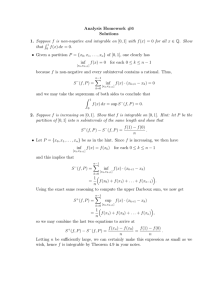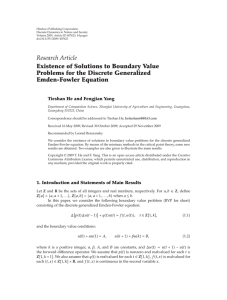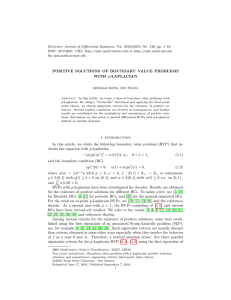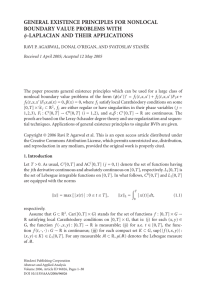Document 10677387
advertisement
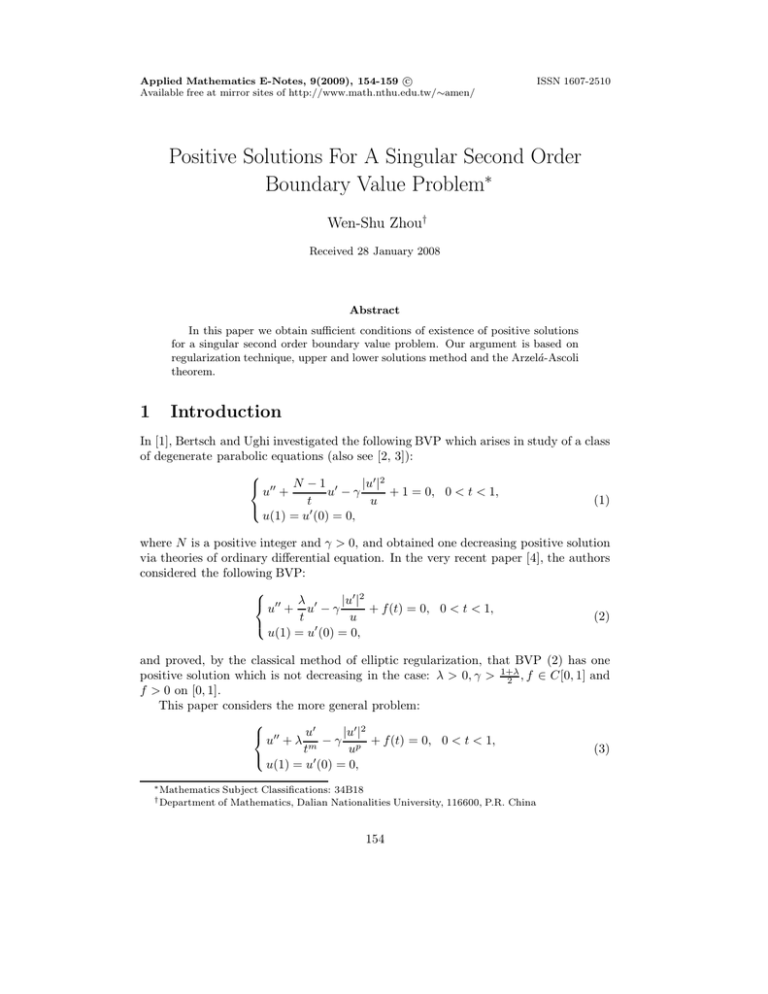
c
Applied Mathematics E-Notes, 9(2009), 154-159 Available free at mirror sites of http://www.math.nthu.edu.tw/∼amen/
ISSN 1607-2510
Positive Solutions For A Singular Second Order
Boundary Value Problem∗
Wen-Shu Zhou†
Received 28 January 2008
Abstract
In this paper we obtain sufficient conditions of existence of positive solutions
for a singular second order boundary value problem. Our argument is based on
regularization technique, upper and lower solutions method and the Arzelá-Ascoli
theorem.
1
Introduction
In [1], Bertsch and Ughi investigated the following BVP which arises in study of a class
of degenerate parabolic equations (also see [2, 3]):
|u0 |2
00 N − 1 0
u +
u −γ
+ 1 = 0, 0 < t < 1,
(1)
t
u
u(1) = u0 (0) = 0,
where N is a positive integer and γ > 0, and obtained one decreasing positive solution
via theories of ordinary differential equation. In the very recent paper [4], the authors
considered the following BVP:
|u0 |2
00 λ 0
u + u −γ
+ f(t) = 0, 0 < t < 1,
(2)
t
u
0
u(1) = u (0) = 0,
and proved, by the classical method of elliptic regularization, that BVP (2) has one
positive solution which is not decreasing in the case: λ > 0, γ > 1+λ
, f ∈ C[0, 1] and
2
f > 0 on [0, 1].
This paper considers the more general problem:
u0
|u0 |2
00
u + λ m − γ p + f(t) = 0, 0 < t < 1,
(3)
t
u
u(1) = u0 (0) = 0,
∗ Mathematics
† Department
Subject Classifications: 34B18
of Mathematics, Dalian Nationalities University, 116600, P.R. China
154
155
W. S. Zhou
where λ, m, γ, p > 0, f(t) ∈ C[0, 1] and f(t) > 0 on [0, 1]. By a solution to BVP (3) we
mean a function u ∈ C 2 (0, 1) ∩ C 1 [0, 1] which is positive in (0, 1) and satisfies (3). By
an argument based on the regularization technique, upper and lower solutions and the
Arzelá-Ascoli theorem, we obtain sufficient conditions of existence of solutions. Our
main result reads
THEOREM 1. Let λ ∈ (0, +∞), p ∈ [1, 2), m ∈ (0, p/(2 − p)], and let f ∈ C[0, 1]
and f(t) > 0 on [0, 1]. If γ > inf G(t), where G(t) : R+ → R+ is defined by
t>1
G(t) =
p + λ(2 − p) p−1 (2 − p)2 max[0,1] f p−2
t
+
t ,
2
4
then BVP (3) has at least one solution.
REMARK 1. If p = 1, then inf G(t) =
t>1
1+λ
.
2
Clearly, Theorem 1 is an extension of
the existence results of [1, 4].
REMARK 2. Let p ∈ (1, 2), and denote
(2 − p)3 max[0,1] f
T0 =
,
2(p − 1)[p + λ(2 − p)]
T∗ =
(
T0 ,
1,
T0 > 1,
T0 < 1.
Then inf G(t) = G(T∗ ). Indeed, since lim G(t) = lim G(t) = +∞, G(t) must reach a
t>1
t→+∞
t→0+
minimum at some point t ∈ (0, ∞) such that G 0 (t) = 0, and then, solving this equation
yields t = T0 and hence, inf G(t) = G(T0 ). Since G 0 (t) > 0 for all t > T0 , we see that
t>0
inf G(t) = inf G(t) = G(T0 ) if T0 > 1, and inf G(t) = G(1) if T0 < 1.
t>0
t>1
2
t>1
Proof of Theorem 1
Let ∈ (0, 1), and define H (t, v, ξ) : (0, 1) × R × R → R by
H(t, v, ξ) = −λ
where α =
2
2−p ,
ξ
|ξ|2
− f(t),
+
γ
[I(v)]p
(t + 1/α )m
and I (v) = v + 2 if v > 0, I (v) = 2 if v < 0. We have
|ξ|2
|ξ|
+
γ
+ max f
2p
[0,1]
m/α
λ
γ
2
6 m/α (1 + |ξ| ) + 2p |ξ|2 + max f
[0,1]
λ
γ
6 m/α + 2p + max f H(|ξ|)
[0,1]
|H(t, v, ξ)| 6
λ
(4)
for all (t, v, ξ) ∈ (0, 1) × R × R, where H(s) = 1 + s2 for s > 0. Define operator
L : C 2 (0, 1) → C(0, 1) by
(L u)(t) = −u00 + H(t, u, u0), 0 < t < 1.
156
Positive Solutions for a BVP
Consider the problem:
(
(L u)(t) = 0, 0 < t < 1,
u(1) = u(0) = 0.
(5)
We call u an upper solution (lower solution) of problem (5) if L u > (6)0 in (0, 1), and
u(t) > (6)0 for t = 0, 1.
We will apply the upper and lower solutions method (see [5, pp.153, Theorem 2.5.4]
or [6, Theorem 1 and Remark 2.4]) to obtain one positive solution of problem (5). Note
R +∞ s
that 0
H(s) ds = +∞. Then it suffices to find a lower solution and an upper solution
to obtain a solution.
2
, where W (t) =
2−p
2−p 2
γC1 α 6 min f(t). Then
[0,1]
LEMMA 1. Let U = C1 W α with α =
such that 2C1 α + C1 αλ2
α−1−m
+
t(1 − t) and C1 ∈ (0, 1)
U is a lower solution of
problem (5).
PROOF. Note that W 00 = −2, W 6 t and |W 0 | 6 1 on [0, 1]. Since U > 0 in (0, 1),
some calculations give by noticing α > 1 + m
U0
|U 0 |2
+γ
− f(t)
1/α
m
(t + )
(U + 2 )p
U0
|U 0 |2
6 −U 00 − λ
+
γ
− f(t)
(t + 1/α )m
Up
L U = −U 00 − λ
= 2C1 αW α−1 − C1 α(α − 1)W α−2 |W 0 |2
W α−1 W 0
+ γC12−p α2 |W 0 |2 − f(t)
(t + 1/α )m
W α−1 W 0
6 2C1 αW α−1 + C1 αλ
+ γC12−p α2 |W 0 |2 − f(t)
(t + 1/α )m
+ C1 αλ
6 2C1 α + C1 αλ(t + 1/α )α−1−m + γC12−p α2 − f(t)
6 2C1 α + C1 αλ2α−1−m + γC12−p α2 − min f(t)
[0,1]
6 0, 0 < t < 1.
Thus, U is a lower solution of problem (5). The lemma follows.
Let inf H(s) ≡ δ. Then it follows from the definition of infimum and γ > δ that
s>1
γ−δ
2
for δ0 =
> 0, there exists C∗ > 1, such that H(C∗ ) < δ + δ0 < γ.
LEMMA 2. There exists a positive constant 0 ∈ (0, 1), such that for any ∈ (0, 0),
1
V = C∗ (t + α )α is an upper solution of problem (5).
157
W. S. Zhou
PROOF. Noticing α > 2 and 1 + m 6 α, we have
L V = −V00 − λ
V0
|V0 |2
+γ
− f(t)
1/α
m
(t + )
(V + 2 )p
= −C∗ α(α − 1)(t + 1/α )α−2 − λαC∗ (t + 1/α )α−1−m
+ γC∗2−p α2 [1 + 2 C∗−1 (t + 1/α )−α ]−p − f(t)
> −C∗ α(α − 1)[1 + 1/α ]α−2 − λαC∗[1 + 1/α ]α−1−m
+ γC∗2−p α2 [1 + C∗−1 ]−p − max f(s)
[0,1]
=
γC∗2−p α2
− C∗ α(α − 1) − λαC∗ − max f(s) + e
[0,1]
= C∗2−pα2 (γ − G(C∗ )) + e ,
0 < t < 1,
where e = C∗α(α −1)[1−(1+1/α )α−2 ]+λαC∗ [1−(1+1/α )α−1−m ]+[1+C∗−1 ]−p −1.
Clearly, e → 0, ( → 0). Since γ > G(C∗ ), there exists 0 ∈ (0, 1) such that
C∗2−pα2 (γ − G(C∗ )) + e > 0.
This shows that for any ∈ (0, 0 ), L V > 0, 0 < t < 1. The lemma follows.
According to [5, pp.153, Theorem 2.5.4] or [6, Theorem 1 and Remark 2.4], for any
fixed ∈ (0, 0 ), problem (5) has a solution u ∈ C 1 [0, 1] satisfying u0 ∈ C 1 (0, 1) and
V > u > U > 0, t ∈ (0, 1).
(6)
Hence u satisfies
u00 + λ
u0
|u0|2
+ f(t) = 0, 0 < t < 1.
−
γ
(u + 2 )p
(t + 1/α )m
(7)
LEMMA 3. There exists a positive constant C2 independent of , such that for all
∈ (0, 0)
|u0(t)| 6 C2 , t ∈ [0, 1].
(8)
PROOF. It follows from u (1) = u (0) = 0 and u > 0 for all t ∈ [0, 1] that
u0 (0) > 0 > u0 (1).
Integrating (7) over (0, 1) and integrating by parts give
1
Z 1
1
u
λu (t) 0
u(t) +
+ mλ
dt
1/α
m
1/α
0
(t + ) 0
)1+m
0 (t + Z 1
Z 1
|u0|2
dt
+
f(t)dt = 0,
−γ
2 p
0 (u + )
0
and then, we obtain by (9)
1
Z 1
Z 1
Z 1
|u0|2
λu (t) u
γ
dt 6
+ mλ
dt +
f(t)dt.
2 p
1/α )1+m
(t + 1/α )m 0
0 (u + )
0 (t + 0
(9)
158
Positive Solutions for a BVP
1
λu (t) p
2
Since m 6 2−p
, 1 + m 6 α = 2−p
. From (6), it is easy to see that (t+
+
1/α )m 0
R1
u
mλ 0 (t+1/α
dt is uniformly bounded and hence, there exists a positive constant
)1+m
C3 independent of , such that
Z 1
|u0 |2
(10)
dt 6 C3 .
2 p
0 (u + )
By the inequality: a 6 a2 + 1 (a ∈ R), we obtain
|u0 |
|u0 |2
6
+ 1,
(t + 1/α )m
(t + 1/α )2m
t ∈ [0, 1].
(11)
By (6), we have u + 2 6 2C∗(t + 1/α )α , t ∈ [0, 1]. Noticing αp > 2m, we see that
there exists a positive constant C4 independent of , such that
(u + 2 )p 6 C4 (t + 1/α )2m ,
t ∈ [0, 1].
Combining this and (11) we obtain
|u0|
|u0|2
+ 1,
6
C
4
(u + 2 )p
(t + 1/α )m
which and (10) imply that
Z
0
1
t ∈ [0, 1],
|u0|
dt 6 C3 C4 + 1 ≡ C5 .
(t + 1/α )m
(12)
On the other hand, integrating (7) over (t1 , t2 ), we have
Z t2
Z t2
Z t2
t 2
u0
|u0|2
0
dt −
f(t)dt.
u (t) = −λ
dt + γ
2 p
1/α )m
t1
t1 (t + t1 (u + )
t1
Combining this with (10) and (12) we obtain for all ∈ (0, 0)
|u0(t2 ) − u0 (t1 )| 6 C6 ,
∀t1 , t2 ∈ [0, 1],
(13)
R1
where C6 = λC5 + γC3 + 0 f(t)dt. Noticing u(1) = u (0) = 0 and using the mean
value theorem, there exists t ∈ (0, 1), such that u0(t ) = 0. Then taking t1 = t in
(13), we obtain the desired result.
By (6) and (8), we derive from (7) that there exists for any δ ∈ (0, 1/2) a positive
constant Cδ independent of , such that for all ∈ (0, 0 )
|u00 (t)| 6 Cδ , δ 6 t 6 1 − δ.
From this and (8) and using Arzelá-Ascoli theorem, there exist a subsequence of {u },
still denoted by {u }, and a function u ∈ C 1 (0, 1) ∩ C[0, 1] such that, as → 0,
u → u, uniformly in C[0, 1],
u → u, uniformly in C 1 [δ, 1 − δ],
159
W. S. Zhou
and hence, by u(1) = u (0) = 0 and (6), u satisfies u(1) = u(0) = 0, C∗ tα > u(t) >
u(t)
C1 [t(1 − t)]α for all t ∈ [0, 1], therefore u(t) > 0 for all t ∈ (0, 1), and u0 (0) = lim t =
t→0
0. Then u satisfies the boundary conditions in (3).
Below, we show that u satisfies the equation in (3). Integrating (7) over [t0 , t] yields
u0 (t) = γ
Z
t
t0
|u0|2
ds − λ
(u + 2 )p
Z
t
t0
u0
ds −
(s + 1/α )m
Z
t
t0
f(s)ds + u0(t0 ),
and letting → 0 and using Lebesgue dominated convergence theorem, we have
Z t 02
Z t 0
Z t
|u |
u
u0 (t) = γ
ds
−
λ
ds
−
f(s)ds + u0 (t0 ), 0 < t < 1.
(14)
p
m
t0 u
t0 s
t0
From this, we see that u ∈ C 2 (0, 1) and satisfies the equation in (3).
It remains to show that u0 is continuous at t = 0 and t = 1. Letting → 0 in (10)
and (12) and using Fatou’s Lemma, we have
Z
0 2
1
0
|u0 |2
dt 6 C3 ,
up
Z
0
1
|u0 |
dt 6 C5 ,
tm
0
|
which show that |uup| , |u
∈ L1 [0, 1]. By the absolute continuity of integral, we see
tm
0
from (14) that u ∈ C[0, 1]. Theorem 1 is proved.
Acknowledgment. The author wants to thank the referee for his important comments which improve this paper. This research is supported by Dalian Nationalities
University (no.20076209).
References
[1] M. Bertsch and M. Ughi, Positivity properties of viscosity solutions of a degenerate
parabolic equation, Nonlinear Anal., 14(1990), 571–592.
[2] M. Bertsch, R. Dal Passo and M. Ughi, Discontinuous viscosity solutions of a degenerate parabolic equation, Trans. Amer. Math. Soc., 320(2)(1990), 779–798.
[3] G. I. Barenblatt, M. Bertsch and A. E. Chertock, V.M. Prostokishin, Self-similar
intermediate asymptotic for a degenerate parabolic filtration-absorption equation.
Proc. Nat. Acad. Sci. (USA), 18(97)(2000), 9844–9848.
[4] W. Zhou and S. Cai, Positive solutions to a singular differential equation of second
order, Nonlinear Anal., 68 (2008), 2319-2327.
[5] D. Guo, J. Sun and Z. Liu, Functional Methods for Nonlinear Ordinary Differential
Equations, Shandong Science and Technology Press, Jinan, 2005. (Chinese)
[6] D. Jiang and W. Gao, Singular boundary value problems for the one-dimension
p-Laplacian, J. Math. Anal. Appl., 270 (2002), 561–581.




